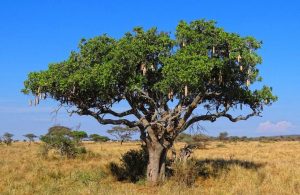Spider plant, Cleome gynandra, also known as African cabbage, spider wisp, and cat’s whiskers is a wild green leafy vegetable that grows all over tropical Africa, Asia, and America.
The origin of Cleome gynandra is not known. There are claims that it has a southern Asian origin, but others suggest that it originated from Africa or Central America. Though the popular belief is that the plant most likely originated in Eastern Africa, in Ethiopia or Somalia. It is an erect, branching plant generally between 25 cm and 60 cm tall. Its sparse leaves are each made up of 3-5 oval-shaped leaflets. The flowers are white to rose pink. The seed is brown, 1.5mm diameter sphere. Popularly known as Spider plant, it belongs to family: Cleomaceae; Genus: Cleome; Species: Cleome gynandra.
Cleome gynandra is important as a leafy vegetable in the following African countries: Nigeria, Dr. Congo, Malawi, Zimbabwe, Cameroon, Botswana, Namibia, Swaziland, Tanzania, Zambia, South Africa, Ghana, Uganda and Kenya. Fresh leaves are cooked and eaten as spinach or dried and stored for later use as a relish with porridge. It is a highly recommended meal for pregnant and lactating women. Cleome gynandra leaves are rich in the minerals calcium and potassium, and it also contains iron, copper, magnesium, sodium and zinc. It contains vitamin C in the form of ascorbic acid and beta-carotene. Its flavonoids are thought to be responsible for the anti-inflammatory and antinociceptive actions of the plant.
In traditional medicine systems, Cleome gynandra plant has a whole host of uses, with the leaves having counter-irritant properties. These are used in poultices or applied to relive the pains of rheumatism and arthritis. The juice extracted from the leaves is used for management of earache and epilepsy. The boiled leaves are given to pregnant women and are eaten before and immediately after childbirth. It is said that they help to make the birth easy and they help replenish the lost blood during childbirth. They are also given to warriors who have lost blood due to injuries.
An infusion of the leaves is given for management of anaemia. Infusions of the chopped roots are used for chest pains, and an infusion of the leaves is used to stop diarrhoea. One cupful of the root infusion is given to ease childbirth by the Traditional Birth Attendants (TBAs).
The decoction or infusion of the roots or an infusion of the boiled leaves is used to get rid of intestinal worms, for ear problems, gastroenteritis, and other similar problems; the oil is used on tumours and for enlarged prostate glands.
A decoction of the root is used for fever, including malaria, and the anti-inflammatory properties of the leaves make them useful in the treatment of pink eye (conjunctivitis).
Cleome gynandra consumption is important in management of cognitive and age-related memory loss diseases, and in treating diabetes, heart problems, kidney problems, ulcers, blood pressure and many other ailments.
In Ayurveda – Indian Traditional Medicine – it is used as treatment of pain, swelling, fever, asthma, and skin diseases. Seed powder of this plant has carminative, antiseptic, and anthelmintic properties. The leaves have anti-inflammatory and sudorific properties. Traditionally few drops of leaves juice are put into the ear to treat ear pain. For painful joints leaves and seeds poultice is used. Leaves may be crushed to make a concoction that is drunk to cure diseases such as scurvy. In many cultures, boiled leaves are regarded as a medicinal meal.
A decoction or infusion of boiled leaves and/ or roots is administered to facilitate childbirth in pregnant women, treat stomach-ache and constipation, treat conjunctivitis, treat severe thread worm infection, relieve chest pains, Arthritis is treated with the leaves, The leaves have anti-inflammatory properties.
In other communities, leaves are boiled and marinated in sour milk for 2-3 days and eaten as a nutritious meal, which is believed to improve eyesight, provide energy and cure Marasmus.
Eating the vegetable is believed to reduce dizzy spells in pregnant women. It is believed that regular consumption of the leaves by pregnant women will ease childbirth by reducing the length of their labour, and will help them regain normal health more quickly afterwards.
– Richard Komakeck






